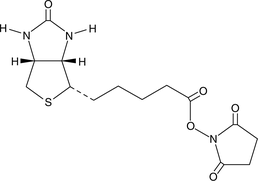Chemicals
Showing 11551–11700 of 41137 results
-
Biocytin is a conjugate of biotin and lysine known formally as ɛ-N-(d-biotinyl)-L-lysine. The addition of lysine to biotin increases the chain length extending from biotin, allowing the synthesis of medium-chain reagents. It also provides terminal carboxyl and amino groups for derivatization or conjugation to proteins and other molecules. Covalent linking reactions typically involve carbodiimide or NHS-ester crosslinking chemistries. Biocytin is also used as an anterograde, retrograde, or intracellular neuroanatomical tracer that is fixable with aldehyde-based fixatives.{27363,27362,27364} For this and other applications, biocytin is detected with avidin or streptavidin probes.
Brand:CaymanSKU:-Out of stock
Biocytin is a conjugate of biotin and lysine known formally as ɛ-N-(d-biotinyl)-L-lysine. The addition of lysine to biotin increases the chain length extending from biotin, allowing the synthesis of medium-chain reagents. It also provides terminal carboxyl and amino groups for derivatization or conjugation to proteins and other molecules. Covalent linking reactions typically involve carbodiimide or NHS-ester crosslinking chemistries. Biocytin is also used as an anterograde, retrograde, or intracellular neuroanatomical tracer that is fixable with aldehyde-based fixatives.{27363,27362,27364} For this and other applications, biocytin is detected with avidin or streptavidin probes.
Brand:CaymanSKU:-Out of stock
Biocytin is a conjugate of biotin and lysine known formally as ɛ-N-(d-biotinyl)-L-lysine. The addition of lysine to biotin increases the chain length extending from biotin, allowing the synthesis of medium-chain reagents. It also provides terminal carboxyl and amino groups for derivatization or conjugation to proteins and other molecules. Covalent linking reactions typically involve carbodiimide or NHS-ester crosslinking chemistries. Biocytin is also used as an anterograde, retrograde, or intracellular neuroanatomical tracer that is fixable with aldehyde-based fixatives.{27363,27362,27364} For this and other applications, biocytin is detected with avidin or streptavidin probes.
Brand:CaymanSKU:-Out of stock
Biotin is an essential coenzyme for certain carboxylases. It is used to modify histones and regulate gene transcription.{37060}{37061}{37062} Biotin-dependent carboxylases are involved in fatty acid and amino acid synthesis, and play a role in gluconeogenesis.{37060} In addition, biotin is used in biotechnological applications such as DNA-hybridization, flow cytometry, affinity purification, and identification of protein-protein interactions and post-translational modifications.{37063}
Brand:CaymanSKU:22582 -Out of stock
Biotin is an essential coenzyme for certain carboxylases. It is used to modify histones and regulate gene transcription.{37060}{37061}{37062} Biotin-dependent carboxylases are involved in fatty acid and amino acid synthesis, and play a role in gluconeogenesis.{37060} In addition, biotin is used in biotechnological applications such as DNA-hybridization, flow cytometry, affinity purification, and identification of protein-protein interactions and post-translational modifications.{37063}
Brand:CaymanSKU:22582 -Out of stock
Biotin is an essential coenzyme for certain carboxylases. It is used to modify histones and regulate gene transcription.{37060}{37061}{37062} Biotin-dependent carboxylases are involved in fatty acid and amino acid synthesis, and play a role in gluconeogenesis.{37060} In addition, biotin is used in biotechnological applications such as DNA-hybridization, flow cytometry, affinity purification, and identification of protein-protein interactions and post-translational modifications.{37063}
Brand:CaymanSKU:22582 -Out of stock
Biotin is an essential coenzyme for certain carboxylases. It is used to modify histones and regulate gene transcription.{37060}{37061}{37062} Biotin-dependent carboxylases are involved in fatty acid and amino acid synthesis, and play a role in gluconeogenesis.{37060} In addition, biotin is used in biotechnological applications such as DNA-hybridization, flow cytometry, affinity purification, and identification of protein-protein interactions and post-translational modifications.{37063}
Brand:CaymanSKU:22582 -Out of stock
Biotin hydrazide is a biotinyl derivative used to label surface functional groups, antibodies, lectins, sugars, nucleic acids, or molecules with free carboxylic or keto groups.{29863} Biotin hydrazide is used as a probe for determining protein carbonylation, an irreversible posttranslational modification resulting from the actions of reactive oxygen species or lipid oxidation products.{29864} The reaction of this probe is direct and does not require catalysts or reducing agents.
Brand:CaymanSKU:-Available on backorder
Biotin hydrazide is a biotinyl derivative used to label surface functional groups, antibodies, lectins, sugars, nucleic acids, or molecules with free carboxylic or keto groups.{29863} Biotin hydrazide is used as a probe for determining protein carbonylation, an irreversible posttranslational modification resulting from the actions of reactive oxygen species or lipid oxidation products.{29864} The reaction of this probe is direct and does not require catalysts or reducing agents.
Brand:CaymanSKU:-Available on backorder
Biotin hydrazide is a biotinyl derivative used to label surface functional groups, antibodies, lectins, sugars, nucleic acids, or molecules with free carboxylic or keto groups.{29863} Biotin hydrazide is used as a probe for determining protein carbonylation, an irreversible posttranslational modification resulting from the actions of reactive oxygen species or lipid oxidation products.{29864} The reaction of this probe is direct and does not require catalysts or reducing agents.
Brand:CaymanSKU:-Available on backorder
Biotin hydrazide is a biotinyl derivative used to label surface functional groups, antibodies, lectins, sugars, nucleic acids, or molecules with free carboxylic or keto groups.{29863} Biotin hydrazide is used as a probe for determining protein carbonylation, an irreversible posttranslational modification resulting from the actions of reactive oxygen species or lipid oxidation products.{29864} The reaction of this probe is direct and does not require catalysts or reducing agents.
Brand:CaymanSKU:-Available on backorder
Biotin LC hydrazide is a reactive probe that is used to biotinylate carboxyl or vicinal hydroxyl groups on carbohydrates, glycoproteins, or other glycoconjugates.{29863} It can also be used to link biotin to antibodies and ribonucleotides.{29863,17906} Biotin LC hydrazide contains a long spacer arm to prevent steric hindrances.
Brand:CaymanSKU:21497 -Out of stock
Biotin LC hydrazide is a reactive probe that is used to biotinylate carboxyl or vicinal hydroxyl groups on carbohydrates, glycoproteins, or other glycoconjugates.{29863} It can also be used to link biotin to antibodies and ribonucleotides.{29863,17906} Biotin LC hydrazide contains a long spacer arm to prevent steric hindrances.
Brand:CaymanSKU:21497 -Out of stock
Biotin LC hydrazide is a reactive probe that is used to biotinylate carboxyl or vicinal hydroxyl groups on carbohydrates, glycoproteins, or other glycoconjugates.{29863} It can also be used to link biotin to antibodies and ribonucleotides.{29863,17906} Biotin LC hydrazide contains a long spacer arm to prevent steric hindrances.
Brand:CaymanSKU:21497 -Out of stock
Biotin LC hydrazide is a reactive probe that is used to biotinylate carboxyl or vicinal hydroxyl groups on carbohydrates, glycoproteins, or other glycoconjugates.{29863} It can also be used to link biotin to antibodies and ribonucleotides.{29863,17906} Biotin LC hydrazide contains a long spacer arm to prevent steric hindrances.
Brand:CaymanSKU:21497 -Out of stock
Biotin tripeptide-1 is an extracellular matrix (ECM) peptide that has been conjugated to biotin (Item No. 22582).{47444} It stimulates the production of collagen IV and laminin in dermal and epidermal cells ex vivo. Biotin tripeptide-1 localizes to the peri-pilial zone of isolated cultured human hair follicles, induces proliferation of keratinocytes, and increases hair growth by 58 and 121% compared with control follicles when used at concentrations of 2 and 5 ppm, respectively.{47445} It also prevents decreases in the collagen IV and laminin 5 bands of isolated cultured hair follicles.
Brand:CaymanSKU:27153 - 100 mgAvailable on backorder
Biotin tripeptide-1 is an extracellular matrix (ECM) peptide that has been conjugated to biotin (Item No. 22582).{47444} It stimulates the production of collagen IV and laminin in dermal and epidermal cells ex vivo. Biotin tripeptide-1 localizes to the peri-pilial zone of isolated cultured human hair follicles, induces proliferation of keratinocytes, and increases hair growth by 58 and 121% compared with control follicles when used at concentrations of 2 and 5 ppm, respectively.{47445} It also prevents decreases in the collagen IV and laminin 5 bands of isolated cultured hair follicles.
Brand:CaymanSKU:27153 - 25 mgAvailable on backorder
Biotin tripeptide-1 is an extracellular matrix (ECM) peptide that has been conjugated to biotin (Item No. 22582).{47444} It stimulates the production of collagen IV and laminin in dermal and epidermal cells ex vivo. Biotin tripeptide-1 localizes to the peri-pilial zone of isolated cultured human hair follicles, induces proliferation of keratinocytes, and increases hair growth by 58 and 121% compared with control follicles when used at concentrations of 2 and 5 ppm, respectively.{47445} It also prevents decreases in the collagen IV and laminin 5 bands of isolated cultured hair follicles.
Brand:CaymanSKU:27153 - 250 mgAvailable on backorder
Biotin tripeptide-1 is an extracellular matrix (ECM) peptide that has been conjugated to biotin (Item No. 22582).{47444} It stimulates the production of collagen IV and laminin in dermal and epidermal cells ex vivo. Biotin tripeptide-1 localizes to the peri-pilial zone of isolated cultured human hair follicles, induces proliferation of keratinocytes, and increases hair growth by 58 and 121% compared with control follicles when used at concentrations of 2 and 5 ppm, respectively.{47445} It also prevents decreases in the collagen IV and laminin 5 bands of isolated cultured hair follicles.
Brand:CaymanSKU:27153 - 50 mgAvailable on backorder
Biotin-azide is a form of biotin with a terminal azide group. It is used to add biotin to other molecules that bear either an alkyne group, through click chemistry, or a phosphine group, using Staudinger ligation.{20657,18690} Biotin-azide has been commonly used to biotin-tag alkynylated lipids, particularly those associated with proteins through post-translational modification.{20657,27888,27891} It can also be used to biotin-tag proteins, lipids, carbohydrates, and nucleic acids that have been modified with alkyne or phosphine groups.{27889,27887,27890,27886}
Brand:CaymanSKU:13040 - 1 mgAvailable on backorder
Biotin-azide is a form of biotin with a terminal azide group. It is used to add biotin to other molecules that bear either an alkyne group, through click chemistry, or a phosphine group, using Staudinger ligation.{20657,18690} Biotin-azide has been commonly used to biotin-tag alkynylated lipids, particularly those associated with proteins through post-translational modification.{20657,27888,27891} It can also be used to biotin-tag proteins, lipids, carbohydrates, and nucleic acids that have been modified with alkyne or phosphine groups.{27889,27887,27890,27886}
Brand:CaymanSKU:13040 - 10 mgAvailable on backorder
Biotin-azide is a form of biotin with a terminal azide group. It is used to add biotin to other molecules that bear either an alkyne group, through click chemistry, or a phosphine group, using Staudinger ligation.{20657,18690} Biotin-azide has been commonly used to biotin-tag alkynylated lipids, particularly those associated with proteins through post-translational modification.{20657,27888,27891} It can also be used to biotin-tag proteins, lipids, carbohydrates, and nucleic acids that have been modified with alkyne or phosphine groups.{27889,27887,27890,27886}
Brand:CaymanSKU:13040 - 25 mgAvailable on backorder
Biotin-azide is a form of biotin with a terminal azide group. It is used to add biotin to other molecules that bear either an alkyne group, through click chemistry, or a phosphine group, using Staudinger ligation.{20657,18690} Biotin-azide has been commonly used to biotin-tag alkynylated lipids, particularly those associated with proteins through post-translational modification.{20657,27888,27891} It can also be used to biotin-tag proteins, lipids, carbohydrates, and nucleic acids that have been modified with alkyne or phosphine groups.{27889,27887,27890,27886}
Brand:CaymanSKU:13040 - 5 mgAvailable on backorder
Biotin-HPDP is a sulfhydryl-reactive biotinylation reagent that forms a reversible disulfide linkage. It is used to label protein cysteines and other substrates that contain sulfhydryl groups.{26858,26856,26855} Biotin-HPDP is also used in the biotin switch technique to tag S-nitrosylated (SNO) proteins, following reduction of SNO groups to thiols.{12802,23915} Compounds that are tagged with biotin interact avidly with streptavidin-coupled beads, fluorophores, enzymes, etc. The interaction of biotin-HPDP with substrates containing sulfhydryl groups is easily performed at pH 6.5 to 7.5 in buffers such as PBS. The disulfide linkage that is formed between avidin and substrate can later by cleaved by a reducing agent, like dithiothreitol.
Brand:CaymanSKU:-Out of stock
Biotin-HPDP is a sulfhydryl-reactive biotinylation reagent that forms a reversible disulfide linkage. It is used to label protein cysteines and other substrates that contain sulfhydryl groups.{26858,26856,26855} Biotin-HPDP is also used in the biotin switch technique to tag S-nitrosylated (SNO) proteins, following reduction of SNO groups to thiols.{12802,23915} Compounds that are tagged with biotin interact avidly with streptavidin-coupled beads, fluorophores, enzymes, etc. The interaction of biotin-HPDP with substrates containing sulfhydryl groups is easily performed at pH 6.5 to 7.5 in buffers such as PBS. The disulfide linkage that is formed between avidin and substrate can later by cleaved by a reducing agent, like dithiothreitol.
Brand:CaymanSKU:-Out of stock
Biotin-HPDP is a sulfhydryl-reactive biotinylation reagent that forms a reversible disulfide linkage. It is used to label protein cysteines and other substrates that contain sulfhydryl groups.{26858,26856,26855} Biotin-HPDP is also used in the biotin switch technique to tag S-nitrosylated (SNO) proteins, following reduction of SNO groups to thiols.{12802,23915} Compounds that are tagged with biotin interact avidly with streptavidin-coupled beads, fluorophores, enzymes, etc. The interaction of biotin-HPDP with substrates containing sulfhydryl groups is easily performed at pH 6.5 to 7.5 in buffers such as PBS. The disulfide linkage that is formed between avidin and substrate can later by cleaved by a reducing agent, like dithiothreitol.
Brand:CaymanSKU:-Out of stock
Biotin-LC-LC-NHS is a biotinylation reagent that contains an N-hydroxysuccinimide (NHS) moiety, which activates carboxylic acid groups on biotin to facilitate coupling reactions, and a 30.5 Å spacer to decrease steric hindrance.{36757} It has been used to biotinylate small molecules such as paclitaxel (Item No. 10461) and coenzyme Q10 (Item No. 11506) for use in binding site characterization.{36757,36758}
Brand:CaymanSKU:-Available on backorder
Biotin-LC-LC-NHS is a biotinylation reagent that contains an N-hydroxysuccinimide (NHS) moiety, which activates carboxylic acid groups on biotin to facilitate coupling reactions, and a 30.5 Å spacer to decrease steric hindrance.{36757} It has been used to biotinylate small molecules such as paclitaxel (Item No. 10461) and coenzyme Q10 (Item No. 11506) for use in binding site characterization.{36757,36758}
Brand:CaymanSKU:-Available on backorder
Biotin-LC-LC-NHS is a biotinylation reagent that contains an N-hydroxysuccinimide (NHS) moiety, which activates carboxylic acid groups on biotin to facilitate coupling reactions, and a 30.5 Å spacer to decrease steric hindrance.{36757} It has been used to biotinylate small molecules such as paclitaxel (Item No. 10461) and coenzyme Q10 (Item No. 11506) for use in binding site characterization.{36757,36758}
Brand:CaymanSKU:-Available on backorder
N-Hydroxysuccinimide (NHS) activates carboxylic acid groups (on biotin) to facilitate coupling reactions. Biotin-NHS is a compound used to attach biotin to primary amines under alkaline conditions (pH~8-9). For example, lysines on the surface of proteins, including antibodies, are ideal targets for biotinylation with this compound.
Brand:CaymanSKU:-N-Hydroxysuccinimide (NHS) activates carboxylic acid groups (on biotin) to facilitate coupling reactions. Biotin-NHS is a compound used to attach biotin to primary amines under alkaline conditions (pH~8-9). For example, lysines on the surface of proteins, including antibodies, are ideal targets for biotinylation with this compound.
Brand:CaymanSKU:-N-Hydroxysuccinimide (NHS) activates carboxylic acid groups (on biotin) to facilitate coupling reactions. Biotin-NHS is a compound used to attach biotin to primary amines under alkaline conditions (pH~8-9). For example, lysines on the surface of proteins, including antibodies, are ideal targets for biotinylation with this compound.
Brand:CaymanSKU:-N-Hydroxysuccinimide (NHS) activates carboxylic acid groups (on biotin) to facilitate coupling reactions. Biotin-NHS is a compound used to attach biotin to primary amines under alkaline conditions (pH~8-9). For example, lysines on the surface of proteins, including antibodies, are ideal targets for biotinylation with this compound.
Brand:CaymanSKU:-Biotin-PEG3-azide is a PEGylated version of biotin-azide (Item No. 13040) that is more hydrophilic due to the incorporation of a PEGylated spacer. It can be used to label terminal alkynes via copper-catalyzed click reactions or copper-free click reactions with cyclooctynes.{37254},{37253} Biotin-PEG3-azide has been used to non-enzymatically and covalently tag proteins, which can be separated and detected using common laboratory methods such as SDS-PAGE and Western blot.{37252} It can be used in combination with other protein tags. Biotin-PEG3-azide has also been used in nanostructured biointerfaces to study ligand and receptor spacing when there are different signaling molecules present.{37254}
Brand:CaymanSKU:23419 - 10 mgAvailable on backorder
Biotin-PEG3-azide is a PEGylated version of biotin-azide (Item No. 13040) that is more hydrophilic due to the incorporation of a PEGylated spacer. It can be used to label terminal alkynes via copper-catalyzed click reactions or copper-free click reactions with cyclooctynes.{37254},{37253} Biotin-PEG3-azide has been used to non-enzymatically and covalently tag proteins, which can be separated and detected using common laboratory methods such as SDS-PAGE and Western blot.{37252} It can be used in combination with other protein tags. Biotin-PEG3-azide has also been used in nanostructured biointerfaces to study ligand and receptor spacing when there are different signaling molecules present.{37254}
Brand:CaymanSKU:23419 - 25 mgAvailable on backorder
Biotin-PEG3-azide is a PEGylated version of biotin-azide (Item No. 13040) that is more hydrophilic due to the incorporation of a PEGylated spacer. It can be used to label terminal alkynes via copper-catalyzed click reactions or copper-free click reactions with cyclooctynes.{37254},{37253} Biotin-PEG3-azide has been used to non-enzymatically and covalently tag proteins, which can be separated and detected using common laboratory methods such as SDS-PAGE and Western blot.{37252} It can be used in combination with other protein tags. Biotin-PEG3-azide has also been used in nanostructured biointerfaces to study ligand and receptor spacing when there are different signaling molecules present.{37254}
Brand:CaymanSKU:23419 - 5 mgAvailable on backorder
Biotin-PEG3-azide is a PEGylated version of biotin-azide (Item No. 13040) that is more hydrophilic due to the incorporation of a PEGylated spacer. It can be used to label terminal alkynes via copper-catalyzed click reactions or copper-free click reactions with cyclooctynes.{37254},{37253} Biotin-PEG3-azide has been used to non-enzymatically and covalently tag proteins, which can be separated and detected using common laboratory methods such as SDS-PAGE and Western blot.{37252} It can be used in combination with other protein tags. Biotin-PEG3-azide has also been used in nanostructured biointerfaces to study ligand and receptor spacing when there are different signaling molecules present.{37254}
Brand:CaymanSKU:23419 - 50 mgAvailable on backorder
Biotin-PEG4-NHS is an amine reactive reagent that contains biotin linked via a four-unit PEG spacer to N-hydroxysuccinimide (NHS), which facilitates the coupling of biotin to primary amines.{45980} Biotin-PEG4-NHS has been used in the biotinylation of proteins and antibodies.{45981,45982}
Brand:CaymanSKU:29114 - 100 mgAvailable on backorder
Biotin-PEG4-NHS is an amine reactive reagent that contains biotin linked via a four-unit PEG spacer to N-hydroxysuccinimide (NHS), which facilitates the coupling of biotin to primary amines.{45980} Biotin-PEG4-NHS has been used in the biotinylation of proteins and antibodies.{45981,45982}
Brand:CaymanSKU:29114 - 25 mgAvailable on backorder
Biotin-PEG4-NHS is an amine reactive reagent that contains biotin linked via a four-unit PEG spacer to N-hydroxysuccinimide (NHS), which facilitates the coupling of biotin to primary amines.{45980} Biotin-PEG4-NHS has been used in the biotinylation of proteins and antibodies.{45981,45982}
Brand:CaymanSKU:29114 - 50 mgAvailable on backorder
Biotin-VAD-FMK is a biotin-conjugated form of the pan-caspase inhibitor Z-VAD(OH)-FMK (Item No. 14467).{9853} It is an affinity probe that allows for detection and immobilization of caspases using the biotin ligand. Biotin-VAD-FMK inhibits caspase-3-like activity in a dose-dependent manner in hepatocytes stimulated with TNF-α and ActD. It also binds to caspase-3 and caspase-8 in hepatocyte lysates, an effect that can be blocked by the caspase inhibitor Ac-DEVD-CHO (Item No. 10017).
Brand:CaymanSKU:24305 - 1 mgAvailable on backorder
N-Hydroxysuccinimide (NHS) activates carboxylic acid groups (on biotin) to facilitate coupling reactions. Biotin-X-NHS is a compound used to attach biotin to primary amines under alkaline conditions (pH~8-9). For example, lysines on the surface of proteins, including antibodies, are ideal targets for biotinylation with this compound. Biotin-X-NHS is like Biotin-NHS (Item No. 13315), but contains a six-atom spacer arm to minimize steric effects.
Brand:CaymanSKU:-N-Hydroxysuccinimide (NHS) activates carboxylic acid groups (on biotin) to facilitate coupling reactions. Biotin-X-NHS is a compound used to attach biotin to primary amines under alkaline conditions (pH~8-9). For example, lysines on the surface of proteins, including antibodies, are ideal targets for biotinylation with this compound. Biotin-X-NHS is like Biotin-NHS (Item No. 13315), but contains a six-atom spacer arm to minimize steric effects.
Brand:CaymanSKU:-N-Hydroxysuccinimide (NHS) activates carboxylic acid groups (on biotin) to facilitate coupling reactions. Biotin-X-NHS is a compound used to attach biotin to primary amines under alkaline conditions (pH~8-9). For example, lysines on the surface of proteins, including antibodies, are ideal targets for biotinylation with this compound. Biotin-X-NHS is like Biotin-NHS (Item No. 13315), but contains a six-atom spacer arm to minimize steric effects.
Brand:CaymanSKU:-N-Hydroxysuccinimide (NHS) activates carboxylic acid groups (on biotin) to facilitate coupling reactions. Biotin-X-NHS is a compound used to attach biotin to primary amines under alkaline conditions (pH~8-9). For example, lysines on the surface of proteins, including antibodies, are ideal targets for biotinylation with this compound. Biotin-X-NHS is like Biotin-NHS (Item No. 13315), but contains a six-atom spacer arm to minimize steric effects.
Brand:CaymanSKU:-Biotin-XX hydrazide is a biotylating reagent for carbohydrates and carbonyl compounds that contains two aminohexanoic spacers to increase the efficiency of avidin-binding by alleviating steric hindrance.{17906}
Brand:CaymanSKU:-Biotin-XX hydrazide is a biotylating reagent for carbohydrates and carbonyl compounds that contains two aminohexanoic spacers to increase the efficiency of avidin-binding by alleviating steric hindrance.{17906}
Brand:CaymanSKU:-Biotin-XX hydrazide is a biotylating reagent for carbohydrates and carbonyl compounds that contains two aminohexanoic spacers to increase the efficiency of avidin-binding by alleviating steric hindrance.{17906}
Brand:CaymanSKU:-Biotinyl tyramide is a reagent that has been used for tyramide signal amplification (TSA) via catalyzed reporter deposition (CARD).{45293} In CARD, a reporter enzyme, such as horseradish peroxidase (HRP) conjugated to a secondary antibody, is bound to the target of interest and catalyzes the covalent deposition of biotinyl tyramide to the sample. The sample is then probed by a detector, such as streptavidin-HRP, allowing detection via chromogenic or fluorescent methods. Biotinyl tyramide has been used in immunohistochemistry, ELISA, Western blot, and in situ hybridization applications.{45293,45294}
Brand:CaymanSKU:27997 - 10 mgAvailable on backorder
Biotinyl tyramide is a reagent that has been used for tyramide signal amplification (TSA) via catalyzed reporter deposition (CARD).{45293} In CARD, a reporter enzyme, such as horseradish peroxidase (HRP) conjugated to a secondary antibody, is bound to the target of interest and catalyzes the covalent deposition of biotinyl tyramide to the sample. The sample is then probed by a detector, such as streptavidin-HRP, allowing detection via chromogenic or fluorescent methods. Biotinyl tyramide has been used in immunohistochemistry, ELISA, Western blot, and in situ hybridization applications.{45293,45294}
Brand:CaymanSKU:27997 - 25 mgAvailable on backorder
Biotinyl tyramide is a reagent that has been used for tyramide signal amplification (TSA) via catalyzed reporter deposition (CARD).{45293} In CARD, a reporter enzyme, such as horseradish peroxidase (HRP) conjugated to a secondary antibody, is bound to the target of interest and catalyzes the covalent deposition of biotinyl tyramide to the sample. The sample is then probed by a detector, such as streptavidin-HRP, allowing detection via chromogenic or fluorescent methods. Biotinyl tyramide has been used in immunohistochemistry, ELISA, Western blot, and in situ hybridization applications.{45293,45294}
Brand:CaymanSKU:27997 - 50 mgAvailable on backorder
Apoptosis is induced by certain cytokines including TNF and Fas ligand in the TNF family through their death domain containing receptors. TNF-related apoptosis-inducing ligand (TRAIL or Apo2L), a member of this family, activates apoptosis in a variety of tumor cell lines by signaling through the death receptors, DR4 and DR5. Bioymifi directly activates DR5 (Kd = 1.2 µM; IC50 = 2 µM), inducing DR5 clustering, which leads to the initiation of FADD/caspase-8-dependent apoptosis in various cancer cells.{29884}
Brand:CaymanSKU:-Apoptosis is induced by certain cytokines including TNF and Fas ligand in the TNF family through their death domain containing receptors. TNF-related apoptosis-inducing ligand (TRAIL or Apo2L), a member of this family, activates apoptosis in a variety of tumor cell lines by signaling through the death receptors, DR4 and DR5. Bioymifi directly activates DR5 (Kd = 1.2 µM; IC50 = 2 µM), inducing DR5 clustering, which leads to the initiation of FADD/caspase-8-dependent apoptosis in various cancer cells.{29884}
Brand:CaymanSKU:-Apoptosis is induced by certain cytokines including TNF and Fas ligand in the TNF family through their death domain containing receptors. TNF-related apoptosis-inducing ligand (TRAIL or Apo2L), a member of this family, activates apoptosis in a variety of tumor cell lines by signaling through the death receptors, DR4 and DR5. Bioymifi directly activates DR5 (Kd = 1.2 µM; IC50 = 2 µM), inducing DR5 clustering, which leads to the initiation of FADD/caspase-8-dependent apoptosis in various cancer cells.{29884}
Brand:CaymanSKU:-Apoptosis is induced by certain cytokines including TNF and Fas ligand in the TNF family through their death domain containing receptors. TNF-related apoptosis-inducing ligand (TRAIL or Apo2L), a member of this family, activates apoptosis in a variety of tumor cell lines by signaling through the death receptors, DR4 and DR5. Bioymifi directly activates DR5 (Kd = 1.2 µM; IC50 = 2 µM), inducing DR5 clustering, which leads to the initiation of FADD/caspase-8-dependent apoptosis in various cancer cells.{29884}
Brand:CaymanSKU:-Biperiden is a muscarinic acetylcholine receptor antagonist of (Kis = 0.48, 6.3, 3.9, 2.4, and 6.3 nM for M1-5 receptors, respectively, in CHO-K1 cells expressing cloned receptors).{22786} It inhibits binding of [3H]quinuclidinyl benzilate (QNB) to muscarinic receptors in tissue homogenates (IC50s = 79, 52, and 38 nM for rat heart, rat lung, and guinea pig lung, respectively) and in vivo (IC50s = 2.5, 1.1, and 1.2 mg/kg for mouse cerebral cortex, cerebellum, and heart, respectively).{39393,39394} Biperiden (1 μM) increases spontaneous and electrically-evoked dopamine (DA) and electrically-evoked acetylcholine (ACh) release from rabbit caudate nucleus slices preincubated with dopamine in vitro.{39395} It is also an uncompetitive NMDA receptor antagonist and inhibits NMDA-evoked ACh release at a concentration of 10 μM.{39396} Biperiden (0.01-1.0 mg/kg) reduces physostigmine-induced tremor in rats in a dose-dependent manner.{39397} Formulations containing biperiden have been used as an adjuvant treatment for Parkinson’s disease.
Brand:CaymanSKU:23775 - 10 mgAvailable on backorder
Biperiden is a muscarinic acetylcholine receptor antagonist of (Kis = 0.48, 6.3, 3.9, 2.4, and 6.3 nM for M1-5 receptors, respectively, in CHO-K1 cells expressing cloned receptors).{22786} It inhibits binding of [3H]quinuclidinyl benzilate (QNB) to muscarinic receptors in tissue homogenates (IC50s = 79, 52, and 38 nM for rat heart, rat lung, and guinea pig lung, respectively) and in vivo (IC50s = 2.5, 1.1, and 1.2 mg/kg for mouse cerebral cortex, cerebellum, and heart, respectively).{39393,39394} Biperiden (1 μM) increases spontaneous and electrically-evoked dopamine (DA) and electrically-evoked acetylcholine (ACh) release from rabbit caudate nucleus slices preincubated with dopamine in vitro.{39395} It is also an uncompetitive NMDA receptor antagonist and inhibits NMDA-evoked ACh release at a concentration of 10 μM.{39396} Biperiden (0.01-1.0 mg/kg) reduces physostigmine-induced tremor in rats in a dose-dependent manner.{39397} Formulations containing biperiden have been used as an adjuvant treatment for Parkinson’s disease.
Brand:CaymanSKU:23775 - 25 mgAvailable on backorder
Biperiden is a muscarinic acetylcholine receptor antagonist of (Kis = 0.48, 6.3, 3.9, 2.4, and 6.3 nM for M1-5 receptors, respectively, in CHO-K1 cells expressing cloned receptors).{22786} It inhibits binding of [3H]quinuclidinyl benzilate (QNB) to muscarinic receptors in tissue homogenates (IC50s = 79, 52, and 38 nM for rat heart, rat lung, and guinea pig lung, respectively) and in vivo (IC50s = 2.5, 1.1, and 1.2 mg/kg for mouse cerebral cortex, cerebellum, and heart, respectively).{39393,39394} Biperiden (1 μM) increases spontaneous and electrically-evoked dopamine (DA) and electrically-evoked acetylcholine (ACh) release from rabbit caudate nucleus slices preincubated with dopamine in vitro.{39395} It is also an uncompetitive NMDA receptor antagonist and inhibits NMDA-evoked ACh release at a concentration of 10 μM.{39396} Biperiden (0.01-1.0 mg/kg) reduces physostigmine-induced tremor in rats in a dose-dependent manner.{39397} Formulations containing biperiden have been used as an adjuvant treatment for Parkinson’s disease.
Brand:CaymanSKU:23775 - 5 mgAvailable on backorder
Biperiden is a muscarinic acetylcholine receptor antagonist of (Kis = 0.48, 6.3, 3.9, 2.4, and 6.3 nM for M1-5 receptors, respectively, in CHO-K1 cells expressing cloned receptors).{22786} It inhibits binding of [3H]quinuclidinyl benzilate (QNB) to muscarinic receptors in tissue homogenates (IC50s = 79, 52, and 38 nM for rat heart, rat lung, and guinea pig lung, respectively) and in vivo (IC50s = 2.5, 1.1, and 1.2 mg/kg for mouse cerebral cortex, cerebellum, and heart, respectively).{39393,39394} Biperiden (1 μM) increases spontaneous and electrically-evoked dopamine (DA) and electrically-evoked acetylcholine (ACh) release from rabbit caudate nucleus slices preincubated with dopamine in vitro.{39395} It is also an uncompetitive NMDA receptor antagonist and inhibits NMDA-evoked ACh release at a concentration of 10 μM.{39396} Biperiden (0.01-1.0 mg/kg) reduces physostigmine-induced tremor in rats in a dose-dependent manner.{39397} Formulations containing biperiden have been used as an adjuvant treatment for Parkinson’s disease.
Brand:CaymanSKU:23775 - 50 mgAvailable on backorder
Brand:CaymanSKU:11054 - 1 gAvailable on backorder
Brand:CaymanSKU:11054 - 5 gAvailable on backorder
Brand:CaymanSKU:11054 - 500 mgAvailable on backorder
The metabotropic glutamate receptor 2 (mGluR2) is a Gi/o-coupled receptor which is expressed on presynaptic nerve terminals and modulates the release of neurotransmitters like glutamate and GABA.{21987} Biphenylindanone A (BINA) is a positive allosteric modulator of mGluR2, stimulating the human and rat receptors with EC50 values of 33.2 and 96 nM, respectively.{21984} It has no effect on glutamate-induced activation of other mGluR types.{21984} BINA can be used on cells, tissues, or animals.{21984,21983} Because of its selectivity for mGluR2, robust in vivo activity, and brain penetrance, BINA can be used to elucidate the role of mGluR2 in such diverse processes as psychosis, schizophrenia, and drug addiction.{21982,21985,21986}
Brand:CaymanSKU:11986 - 10 mgAvailable on backorder
The metabotropic glutamate receptor 2 (mGluR2) is a Gi/o-coupled receptor which is expressed on presynaptic nerve terminals and modulates the release of neurotransmitters like glutamate and GABA.{21987} Biphenylindanone A (BINA) is a positive allosteric modulator of mGluR2, stimulating the human and rat receptors with EC50 values of 33.2 and 96 nM, respectively.{21984} It has no effect on glutamate-induced activation of other mGluR types.{21984} BINA can be used on cells, tissues, or animals.{21984,21983} Because of its selectivity for mGluR2, robust in vivo activity, and brain penetrance, BINA can be used to elucidate the role of mGluR2 in such diverse processes as psychosis, schizophrenia, and drug addiction.{21982,21985,21986}
Brand:CaymanSKU:11986 - 25 mgAvailable on backorder
The metabotropic glutamate receptor 2 (mGluR2) is a Gi/o-coupled receptor which is expressed on presynaptic nerve terminals and modulates the release of neurotransmitters like glutamate and GABA.{21987} Biphenylindanone A (BINA) is a positive allosteric modulator of mGluR2, stimulating the human and rat receptors with EC50 values of 33.2 and 96 nM, respectively.{21984} It has no effect on glutamate-induced activation of other mGluR types.{21984} BINA can be used on cells, tissues, or animals.{21984,21983} Because of its selectivity for mGluR2, robust in vivo activity, and brain penetrance, BINA can be used to elucidate the role of mGluR2 in such diverse processes as psychosis, schizophrenia, and drug addiction.{21982,21985,21986}
Brand:CaymanSKU:11986 - 5 mgAvailable on backorder
Birinapant is a bivalent mimetic of the Diablo homolog known as second mitochondria-derived activator of caspase (Smac). It is an antagonist of cellular inhibitor of apoptosis 1 (cIAP1, or BIRC2), cIAP2 (BIRC3), and XIAP (BIRC4), binding each at nanomolar concentrations.{34146} Birinapant causes rapid cIAP1 degradation, caspase activation, PARP cleavage, and NF-κB activation in breast cancer cells.{34146} It shows in vivo antitumor activity, inducing apoptosis in several types of cancer xenografts in mice.{34147,34148}
Brand:CaymanSKU:19699 -Available on backorder
Birinapant is a bivalent mimetic of the Diablo homolog known as second mitochondria-derived activator of caspase (Smac). It is an antagonist of cellular inhibitor of apoptosis 1 (cIAP1, or BIRC2), cIAP2 (BIRC3), and XIAP (BIRC4), binding each at nanomolar concentrations.{34146} Birinapant causes rapid cIAP1 degradation, caspase activation, PARP cleavage, and NF-κB activation in breast cancer cells.{34146} It shows in vivo antitumor activity, inducing apoptosis in several types of cancer xenografts in mice.{34147,34148}
Brand:CaymanSKU:19699 -Available on backorder
Birinapant is a bivalent mimetic of the Diablo homolog known as second mitochondria-derived activator of caspase (Smac). It is an antagonist of cellular inhibitor of apoptosis 1 (cIAP1, or BIRC2), cIAP2 (BIRC3), and XIAP (BIRC4), binding each at nanomolar concentrations.{34146} Birinapant causes rapid cIAP1 degradation, caspase activation, PARP cleavage, and NF-κB activation in breast cancer cells.{34146} It shows in vivo antitumor activity, inducing apoptosis in several types of cancer xenografts in mice.{34147,34148}
Brand:CaymanSKU:19699 -Available on backorder
Birinapant is a bivalent mimetic of the Diablo homolog known as second mitochondria-derived activator of caspase (Smac). It is an antagonist of cellular inhibitor of apoptosis 1 (cIAP1, or BIRC2), cIAP2 (BIRC3), and XIAP (BIRC4), binding each at nanomolar concentrations.{34146} Birinapant causes rapid cIAP1 degradation, caspase activation, PARP cleavage, and NF-κB activation in breast cancer cells.{34146} It shows in vivo antitumor activity, inducing apoptosis in several types of cancer xenografts in mice.{34147,34148}
Brand:CaymanSKU:19699 -Available on backorder
Bis-(2-chloroisopropyl) ether is a byproduct in the synthesis of ethylene and propylene glycol that has been found in municipal drinking water in the United States and waterways in the Netherlands where it is considered a persistent organic pollutant (POP).{42284} It is mutagenic in the S. typhimurium strains TA 1535 and TA 100 but lacks mutagenic activity in mice.
Brand:CaymanSKU:20683 -Available on backorder
Bis-(2-chloroisopropyl) ether is a byproduct in the synthesis of ethylene and propylene glycol that has been found in municipal drinking water in the United States and waterways in the Netherlands where it is considered a persistent organic pollutant (POP).{42284} It is mutagenic in the S. typhimurium strains TA 1535 and TA 100 but lacks mutagenic activity in mice.
Brand:CaymanSKU:20683 -Available on backorder
Bis-(2-chloroisopropyl) ether is a byproduct in the synthesis of ethylene and propylene glycol that has been found in municipal drinking water in the United States and waterways in the Netherlands where it is considered a persistent organic pollutant (POP).{42284} It is mutagenic in the S. typhimurium strains TA 1535 and TA 100 but lacks mutagenic activity in mice.
Brand:CaymanSKU:20683 -Available on backorder
Bis-(2-chloroisopropyl) ether is a byproduct in the synthesis of ethylene and propylene glycol that has been found in municipal drinking water in the United States and waterways in the Netherlands where it is considered a persistent organic pollutant (POP).{42284} It is mutagenic in the S. typhimurium strains TA 1535 and TA 100 but lacks mutagenic activity in mice.
Brand:CaymanSKU:20683 -Available on backorder
bis-ANS is a high-affinity non-covalent extrinsic fluorescent dye used to analyze protein conformation.{33937} Its predominant interaction with proteins is through its hydrophobic phenyl and naphthyl rings.{33952} bis-ANS has an excitation maxima of 390 nm.{14908} It has an emission maximum of 523 nm when free in solution but undergoes a blue shift with an increase in fluorescence intensity when bound to protein; for example, when bound to intestinal fatty acid binding protein (FAPB2) it has emission maxima of 484-496 nm. bis-ANS has been used to label mechanically damaged neurons in acute brain slices.{33940} It also potently inhibits microtubule assembly.{33938,33939}
Brand:CaymanSKU:21820 -Out of stock
bis-ANS is a high-affinity non-covalent extrinsic fluorescent dye used to analyze protein conformation.{33937} Its predominant interaction with proteins is through its hydrophobic phenyl and naphthyl rings.{33952} bis-ANS has an excitation maxima of 390 nm.{14908} It has an emission maximum of 523 nm when free in solution but undergoes a blue shift with an increase in fluorescence intensity when bound to protein; for example, when bound to intestinal fatty acid binding protein (FAPB2) it has emission maxima of 484-496 nm. bis-ANS has been used to label mechanically damaged neurons in acute brain slices.{33940} It also potently inhibits microtubule assembly.{33938,33939}
Brand:CaymanSKU:21820 -Out of stock
bis-ANS is a high-affinity non-covalent extrinsic fluorescent dye used to analyze protein conformation.{33937} Its predominant interaction with proteins is through its hydrophobic phenyl and naphthyl rings.{33952} bis-ANS has an excitation maxima of 390 nm.{14908} It has an emission maximum of 523 nm when free in solution but undergoes a blue shift with an increase in fluorescence intensity when bound to protein; for example, when bound to intestinal fatty acid binding protein (FAPB2) it has emission maxima of 484-496 nm. bis-ANS has been used to label mechanically damaged neurons in acute brain slices.{33940} It also potently inhibits microtubule assembly.{33938,33939}
Brand:CaymanSKU:21820 -Out of stock
Tacrine is an amino acridine compound that inhibits acetylcholinesterase (AChE), and has been proposed as a clinical treatment for Alzheimer’s disease.{6603} bis(7)-Tacrine is a tacrine dimer, linked via a 7-carbon alkyl spacer. It inhibits AChE with an IC50 of 0.40 nM, making it more than 1,000 times more potent than tacrine.{12097} bis(7)-Tacrine also protects against hydrogen peroxide induced apoptosis in rat pheochromocytoma cells.{12095}
Brand:CaymanSKU:10005836 - 10 mgAvailable on backorder
Tacrine is an amino acridine compound that inhibits acetylcholinesterase (AChE), and has been proposed as a clinical treatment for Alzheimer’s disease.{6603} bis(7)-Tacrine is a tacrine dimer, linked via a 7-carbon alkyl spacer. It inhibits AChE with an IC50 of 0.40 nM, making it more than 1,000 times more potent than tacrine.{12097} bis(7)-Tacrine also protects against hydrogen peroxide induced apoptosis in rat pheochromocytoma cells.{12095}
Brand:CaymanSKU:10005836 - 100 mgAvailable on backorder
Tacrine is an amino acridine compound that inhibits acetylcholinesterase (AChE), and has been proposed as a clinical treatment for Alzheimer’s disease.{6603} bis(7)-Tacrine is a tacrine dimer, linked via a 7-carbon alkyl spacer. It inhibits AChE with an IC50 of 0.40 nM, making it more than 1,000 times more potent than tacrine.{12097} bis(7)-Tacrine also protects against hydrogen peroxide induced apoptosis in rat pheochromocytoma cells.{12095}
Brand:CaymanSKU:10005836 - 5 mgAvailable on backorder
Tacrine is an amino acridine compound that inhibits acetylcholinesterase (AChE), and has been proposed as a clinical treatment for Alzheimer’s disease.{6603} bis(7)-Tacrine is a tacrine dimer, linked via a 7-carbon alkyl spacer. It inhibits AChE with an IC50 of 0.40 nM, making it more than 1,000 times more potent than tacrine.{12097} bis(7)-Tacrine also protects against hydrogen peroxide induced apoptosis in rat pheochromocytoma cells.{12095}
Brand:CaymanSKU:10005836 - 50 mgAvailable on backorder
Bis(methylthio)gliotoxin is a fungal metabolite originally isolated from G. deliquescens that has diverse biological activities.{36971} It inhibits PAF- and collagen-induced platelet aggregation in rabbit platelet-rich plasma (IC50s = 8.4 and 84.2 µM, respectively) but has no effect on arachidonic acid- or ADP-induced platelet aggregation (IC50s = >400 µM).{36972} Bis(methylthio)gliotoxin inhibits growth of HCT116 colon cancer cells (IC50 = 23.56 µM).{36973} It inhibits PAF-induced bronchoconstriction in guinea pigs when administered at a dose of 0.1 mg/kg and is less toxic to mice (LD50 = >500 mg/kg) than gliotoxin (Item No. 11433).{36972,36974} Bis(methylthio)gliotoxin has been used as a serum biomarker in patients infected with invasive aspergillosis.{36975}
Brand:CaymanSKU:26271 - 1 mgAvailable on backorder























